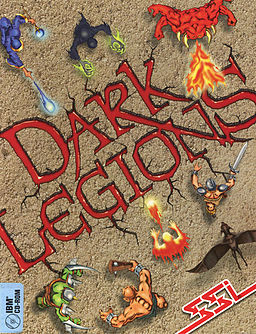- Dark Legions
-
Dark Legions 
Developer(s) Silicon Knights Publisher(s) Strategic Simulations, Inc. (SSI) Distributor(s) SSI Designer(s) Denis Dyack, Rick Goertz, Andrew Summerfield Engine Custom Platform(s) DOS Release date(s) April 1994 Genre(s) Action/Strategy Mode(s) Single player & Multiplayer Rating(s) USK: 12+
OFLC: G8+Media/distribution CD-ROM Dark Legions is a 1994 action strategy game for DOS. It was developed by Silicon Knights and published by Strategic Simulations, Inc. (SSI).[1]
Key features
Some key features of this game include:
- Multi-player head to head (unusual for a DOS game in 1994)
- 16 unit types with unique characteristics and abilities
- A combination of strategic movement with real-time combat
- Purchasing of units at game start allows each player to customize their forces
- Multiple game maps
Many reviewers and players note it as an updated version of the classic computer game Archon: The Light and the Dark.[1]
Description
Dark Legions is an action based strategy game. The player may play against the computer or another human on a strategic game board. In the beginning of the game, the player buys their forces with a predefined number of credits, and may purchase any of the 16 characters along with various kinds of traps and even rings of power to upgrade their creatures. One is chosen to be the "Orb Keeper". The Orb Keeper is like the King in chess: the game is over if he dies. Then players set up on a chosen map and start to move turn wise. When one player moves a piece into the same square as an opponent, the action is instantly transferred to another board map that represents the terrain upon which the two pieces occupy. Each player starts with their single piece on this "melee map" and must fight using their figures. The fight is simultaneously controlled in real time.
Each figure type has unique abilities and at least two attack types. They can be roughly translated into categories however. This categories facing off against each other is the main focus of strategy. Simply put: Casters are hunted by Undead which are hunted by Fighters that fear the Casters spells. These categories are made up as a description and not an inherent part of the game. Hence some odd figures don't fit in any category.
Fodders- weak fighters meant to be expendable
- Berserkers are the cheapest figures (20 Credits). Melee fighters strong enough to hurt casters and not much more.
- Orcs are cheap yet 50% more expensive than Berserkers (30 Credits). They make up for it by superior fighting prowess.
Fighters- nothing else can compare in combat
- Trolls are the toughest melee fighters around and quite cheap (40 Credits). They are the slowest Units by far and can transform into rocks.
- Demons are about as tough as Trolls yet way faster and way more expensive (80 Credits).
- Elementals (Fire/Water) have a ranged attack. They are fast and strong though weaker than Trolls and Demons. In addition, water elementals can stand in bodies of water as well as teleport between them with minimal effort; Fire Elementals can 'go nova' on the strategic map
Casters- comparatively weak in combat, but capable of powerful strategic effects that draw upon their own life force
- Wizards with ranged attack to freeze enemy units on the strategic map and direct combat
- Conjurors can summon Units. These conjurations are as good as the original but lose 10% health per round. Conjurors are the most expensive figures (100 Credits) for a good reason.
- Illusionists can create illusionary Units. These are extremely weak and destroyed immediately if hit. Creating Illusions costs her little life points compared to the Conjuror's Conjurations. In combat, they possess a weak ranged attack and the ability to randomly teleport short distances.
- Templars are healers being best combined with other casters.
- Seers do nothing but spot invisible opponents and traps. They are the weakest of all units in combat.
Undead- specialists between fighting and casting with superior movement abilities
- Wraiths can teleport across the strategic map and have multiple (weak) life leeching attacks in melee
- Phantoms are invisible to one's opponent. They move and attack slowly. Fit to assassinate frail casters or to scout the area.
- Vampires are flying units with the ability to paralyze opponents and drain their hit points in combat. Killed (non-undead, non-elemental) opponents become zombies under the vampire's command. Though their maximum vitality is the highest in the game, vampires grow weaker each turn and must continually find opponents to feed on.
Specialists- those that do not fit into any other category
- Thieves can disarm traps (including a mini game). They are the cheapest ranged fighters (35 Credits).
- Shape Shifters are able to transform into any other unit. This makes them the most versatile figures. Luring opponents by copying the frail or becoming invisible are strategic options. Their statistics copy the form assumed in combat enabling them to counter any opponent with the appropriate form.
Dark Legions was released at almost the same time as the original Warcraft and was in direct competition with this game from the much weaker publisher, SSI.[citation needed] While Dark Legions won acclaim and awards, it was the more frantic and continuous real time combat with the ability of gamers to build mass armies as the game progressed coupled with Warcraft's stronger retail presence that won the sales in the mid '90s and no sequel was ever released.References
- ^ a b Dark Legions at MobyGames
Categories:- 1994 video games
- DOS games
- Action video games
- Silicon Knights games
- Strategic Simulations, Inc. games
- Turn-based strategy video games
- Action game stubs
- Strategy video game stubs
Wikimedia Foundation. 2010.
